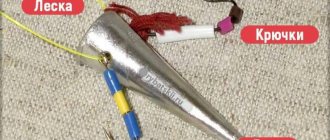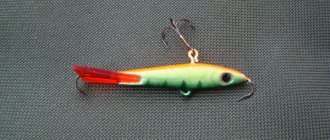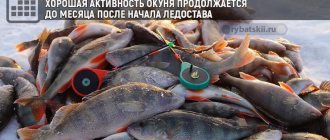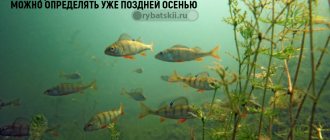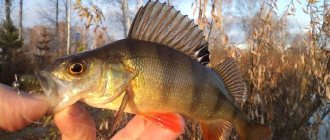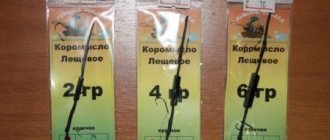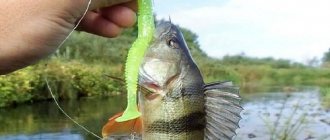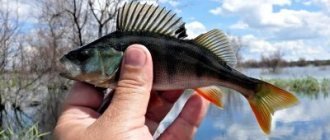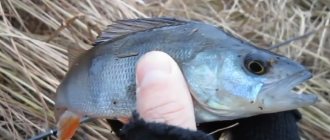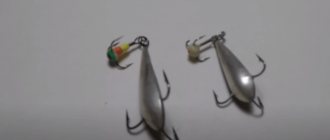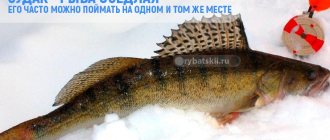Fishermen are creative and imaginative people. It’s impossible to count how many unusual fishing methods and baits they have come up with. “Balda” is one of these unusual baits. It is not known for certain when and where this bait first appeared. The Urals, Siberians, and fishermen from the Moscow region are fighting for the palm. Only one thing is known - the bulldozer is a common bait that has its loyal fans in different regions.
In winter fishing, the balda is known as one of the most effective gear for catching perch. They also successfully catch pike perch with it, and in some places large roach and bream.
What is a fishing rod
The bulldozer is an elongated weight with a thickening or expansion at the bottom, in the narrow part of which there is a transverse hole. A piece of thick and rigid fishing line is passed into the hole, onto which two free-hanging hooks are attached on either side of the weight. The hooks are positioned so that the tip points away from the weight. The fishing line is tied into a knot at the top, as a result of which there is a weight and hooks on the ring of fishing line that move freely along it.
The entire structure is tied to the main fishing line. Often, for ease of installation, a loop of fishing line is tied to winding rings or double-sided swivels. With short swings of the fishing rod and knocking the weight on the bottom, the free-hanging hooks move up and down along the line, attracting fish and provoking it to bite. A weight knocking on the ground raises a cloud of turbidity and imitates an insect or fish swarming at the bottom, and hooks falling down represent larvae raised from the bottom. When the bite is good, it happens that perches sit on both hooks at once .
Main elements of bait
Attaching the boom hooks
Next, we’ll work on attaching the hooks to the body of the bulldozer tackle. According to the conditions of the problem, during a vertical discharge in the water column, the bulldozer must move its hooks - legs.
But for this, the hooks must have rings unfolded before soldering into the body of the bulldozer as shown in the photo.
After that, the oval of the forend ring and the bend of the hook of each hook during the process of attaching the fishing rod to the body should be in the same plane.
The method of attaching the hooks differs from this bait from the do-it-yourself bait, the manufacturing process of which is disclosed on the next page of the site.
In addition, before installing a reelless tackle on the body of the hook rings, the diameter of the internal holes must be increased. Otherwise, we won’t get a high-quality hinge joint.
Therefore, for installation on a fishing rod of this design, it is advisable to find hooks with large rings in the store, or their diameter should be increased with your own hands by bending the rings.
You can expand the hook rings to obtain high-quality hinge joints on the body of the fishing rod using the technology described on the previous page of this topic. Don't forget to solder the joints of the hook rings.
Varieties of bait
Balda for catching perch differs in size and weight of weights. The body of the weight has a length from 1 to 5, and sometimes 7 centimeters. Accordingly, the mass of such cargo differs. The use of one size or another is often determined by the fishing location: depth and presence of current. The shape of the load is in the form of a bullet, pear, elongated bell or cylinder, but most often in the shape of a truncated cone. The wider and heavier part of the sinker is at the bottom point, thanks to this, when playing, the weight does not fall to one side and the hooks play freely.
The debate about whether it is necessary to paint weights and how this affects the bite continues. Most anglers are inclined to think that this is secondary. However, they are often painted red, black or green and combinations thereof. Unpainted weights made of stainless steel, brass or lead are also used.
The equipment of the hooks is of greater importance. Beads, beads, cambrics are put on them, and sometimes the forend is wrapped with thread. In general, the hook is equipped with elements in various combinations that attract fish. The shank of the hook can be filled with beads over the entire length or have one bead. There is no recipe for what is best. On the same body of water, even during the day, the preferences of perch change. Therefore, those who constantly catch perch on the bait have a whole arsenal of baits in different versions and change them during the fishing process. Preferred solutions can only be found based on experience.
It’s good when there are different types of bait and you can experiment
The fishing line used for the loop is rigid and thick, with a diameter of 0.2 - 0.5 mm. This loop does not stretch into one line, does not twist, and ensures free movement of the hooks. Fluorocarbon, which has the necessary characteristics, is often used.
Soldering tackle tackle
We solder the balda tackle with POS-40 or POS-61 solder. Flux is soldering acid. After soldering the reelless bait, rinse the soldered surfaces with warm water.
Under the upper cut of the bait body, that is, under the suspension loop to the tackle, a groove is cut in a circular manner for mounting a homemade wire ring as shown in the photo on the left.
Make sure that the depth of the circular groove is no less than the diameter of the wire used to fasten the hooks. That is, it is advisable to drown the copper wire in the body of the bulldozer. Then it will not protrude on the surface of the tackle body after soldering the bulldozer.
To increase the sector of the hook stroke in the lower direction, we form a longitudinal hollow (photo on the right) using the edge of a triangular file or cut it out with a knife. It is more convenient to perform this operation before mounting and soldering the hooks on the beam.
Next, in the cut groove, a pair of shallow holes are countersunk from two opposite sides using a drill (or the tip of a wide knife blade). They will be needed for the free movement of the hook rings of the tackle around the soldered wire ring.
Why is bait good?
Balda, like any non-standard bait, often catches perch when it doesn’t bite on anything else. Moreover, really large perch can be caught with it. Apparently, this is due to the fact that a seasoned humpback is already able to take something away from someone, regardless of those from whom he takes it. Moreover, this happens when he is not particularly active in order to grab balancers or spinners, and jigs are of little interest to him.
Pike or even grayling may be tempted by such bait.
As already mentioned, the bulldozer is good in currents and depths, that is, where humpback whales like to stand.
How to make a balda yourself
Balda is made independently by those who have accumulated experience in its use, and they already know what exactly they want from the bait. Experienced fishermen are sure that homemade bait is more effective than purchased bait.
Elements for making your own bulldozer
Preparing the weight
The simplest weight is made of lead, and for this it is not necessary to engage in casting. Take a sliding sinker weighing 5–20 grams, like an olive, flatten one side with a hammer, and make a transverse hole on the other side with a thin drill to allow the fishing line to pass through. One narrow end can be sawed off to widen the body of the sinker. A cone sinker is suitable; they are available in different weights. Saw off or bite off the top ring or swivel with pliers and drill a hole. If there is a suitable material - brass or stainless steel rods, then weights are made from them. True, this path is longer and more difficult, since hard materials require serious processing due to the need to use certain tools.
You can use a perch spoon as a load, but you need to “bite off” the hook with pliers first. The weight of the weight depends on the depth where the fishing will take place.
What should the hooks be like?
The main requirement for hooks is the presence of a wide eye. With a standard eye size, even if it seems that the hook slides freely, the bait will not work clearly. Such hooks in the water begin to “stick” to the fishing line and do not come down when playing. You don’t have to go too small with the size of the hooks; perch is not picky in this regard, but a large hook detects fish better. Hooks numbered 5 are suitable for equipping a bulldozer .
Assembling equipment step by step
Once the sinker and suitable hooks have appeared, take a piece of rigid fishing line. The first hook is threaded onto the fishing line, then the weight, then the second hook. When you lift the ends of the fishing line up, it turns out that the weight hangs in the middle, the hooks are on the side with the stings directed away from the weight. Some fishermen add one or two beads or beads on top of the hooks on the fishing line, which also move freely along the fishing line along with the hooks when playing.
Use thicker fishing line so that the hooks “walk” along it better. Diameter 0.20 mm. The main line is already 0.16-0.18 mm.
The ends of the fishing line are tied to a ring, or better yet, a swivel. This will allow you to conveniently tie the main line later. The size of the loop varies, depending on the weight and length of the weight, the size of the hooks, and the preferences of the angler. But more often there are rings with a diameter of 2–5 cm. A smaller diameter will not give the hooks freedom to play; a larger one, in principle, is possible.
Do-it-yourself bulldozer
The process of making do-it-yourself tackle includes soldering operations. Then comes the mechanical processing and painting of the reelless bait, after which the fishing rod acquires the presentation shown in the photograph.
The technology for manufacturing the bulldozer includes a hinged connection of the hooks to the body of the reelless tackle. But to do this, the fastening rings must first be deployed, which is a disadvantage in terms of increasing the time spent on making each vertical bait with your own hands.
But the seats of the hooks in the lead body of the balda limit the range of oscillations of the “legs” of the reelless jig in the vertical plane, which completely eliminates the possibility of the stings of the hook elements catching among themselves.
If you watch a video of the oscillations of the hooks of a do-it-yourself bulldozer of the same design, you can see this with your own eyes.
Making bulldozer tackle with your own hands
To make a balda tackle with your own hands, we take a monolithic lead body in the shape of a truncated cone, in the middle of which, from the wide end, we pierce a blind hole for a short loop for attaching the finished jig to the fishing line of the tackle. See the article: Lead body of a fishing rod.
To securely fasten the loop in the body of the fishing rod, the wire is twisted. The loops and bodies of homemade baits are shown in the photograph. In the process of making each tackle with your own hands, the loop twists will be soldered into the bodies of reelless baits.
Please note that all bait cones are pierced from the wide end. This is an additional guarantee that when the fishing rod is dropped vertically, the hook tips of the reelless gear will not cling to each other.
Making a suspension loop for the tackle
To make your own loops intended for hanging a fishing rod to a fishing line, take a copper wire about 1 mm thick and twist it to a length of 4-6 mm. For better flow of solder during the soldering process, we countersink the hole in the body of the bulge with a drill of a diameter larger than that of the puncture.
By the way, the wire loop serves not only to suspend the bait from the fishing line of the tackle, but also to balance the rod in the water space. The balancing process will be discussed in detail below.
What fishing rod should I use for fishing?
Winter fishing rods with long whip
To catch perch in the winter on the boulder, fishing rods with long whips are used, allowing you to make clear strokes. Some fishermen fish without nods, however, its use is desirable, since the perch sometimes takes it quite delicately and there is a high probability of missing a bite.
Use a nipple or mylar nod, which has good shock absorption.
Perch fishing technique
The technique of fishing with a bulldozer is simple. Unwinding the fishing line, the fisherman finds the bottom with a weight. After this, the slack is removed so as to feel that the load is standing upright, but has not yet come off the bottom. This is followed by a short stroke of the brush and the bait sharply returns to its place, but again so that the load does not fall on its side. In order to control this moment, a nod is precisely what is needed. After a pause of 5–20 seconds, the next swing follows, and so on. The bite, as a rule, follows a pause, and often after several seconds. And the more passive the fish, the more pauses are made.
micro balda is the most catchy winter tackle for perch and roach
Among winter fishing enthusiasts there are many adherents of fishing with various reelless baits, bolds, devils, goats, witches and other “evil spirits”. But for some reason, very few anglers pay due attention to such a universal and catchy bait as a microbalda. And by the way, in vain. For me personally, this bait is probably the number one bait for fishing from ice, if you don’t take into account the classic jig for fishing with bloodworms. You can catch any fish with a microbait, and this bait works great in a variety of bodies of water: natural lakes, reservoirs, river oxbows, and so on. This is due to the fact that this bait reminds the fish of its natural food source.
Microbalda has a number of advantages over other rewinders. The main advantage, I believe, is its ease of learning. This bait is quite easy to “control”. Unlike all sorts of little devils and little devils, for each of which you still need to select the wiring and “teach your hand,” it’s relatively easy to do the wiring with a microbald. Moreover, you can fish with this bait with a variety of nods, ranging from ordinary lavsan nods to springs made of twisted fishing line.
Wiring a microbalda is also quite easy to master. As a rule, this is a regular “uphill” wiring with preliminary tapping on the bottom. Conventionally, wiring with a microbalder can be divided into two types: active and passive. Active retrieving is carried out by a more amplitude “acceleration” of the bait with a nod at a fairly fast lifting speed. As a rule, this wiring is used as a search one, or when the fish is actively feeding. Passive retrieving is the opposite: the rising speed of the bait is very slow, the amplitude of the nod oscillations is minimal. From the outside it may seem that with such wiring the microbalda does not play at all, but this impression is deceptive. Due to the fact that the hooks on the bait hang freely on the fishing line, they begin to “play” and move at the slightest movements of the nod and the rod.
During the retrieve, you can take short pauses, and you should also pause in the final phase of the retrieve, since the fish very often grabs the bait during these pauses. This is especially true when the fish is passive. When it actively feeds, bites usually occur either when the bait is first tapped on the bottom, or when the bait is first lifted. As a rule, 2-3 runs are enough to determine the presence of active fish under the hole. But sometimes there are situations where you need to make 5-6 moves on a hole to get the fish to bite. And as a rule, larger fish that behave more cautiously bite this way.
You shouldn’t hesitate to hook, and you need to hook the fish very quickly and clearly after the bite. This is especially true when we catch roach, since this fish is characterized by very fast and sharp bites, sometimes it literally hits the microbald and it can be quite difficult to hook it.
As for fishing rods, you can use completely different options, but I prefer to fish with balalaikas with a clearly adjusted friction, and preferably with long and soft whips. A customized clutch and a long soft whip are very important when we are fishing at shallow depths (up to 2-3 meters) and quite large fish can bite. Then these two points will help you not to break the bait after hooking and cope with the trophy.
The only thing you should pay attention to, especially for those starting to master this tackle, is how to tie it correctly. Don't make a loop that is too long. The optimal length of the loop is 2 centimeters or so. You should also remember that it is advisable to tie the bait from time to time during the fishing process, especially after catching large fish.
The main fish that are caught with microbalda are perch and roach; in reservoirs it can be used very well to catch bream and bream in feeding holes. But the advantage of this bait is that it collects fish well even without the use of bait.
Therefore, if you are looking for winter fishing gear that will allow you to catch fish in a wide variety of water bodies and conditions, then be sure to try fishing with a microbalda. You will be pleasantly surprised by its simplicity, versatility and catchability.
Mistakes you shouldn't make
Typical mistakes when fishing with balda in winter are excessive slack during pauses, when the weight falls on its side, dragging along the loop with hooks, which is why they do not move along the line and do not attract fish. The second common mistake is frequent swings, as when fishing with a spoon. Small pauses often prevent the hooks from descending all the way to the sinker.
If you haven’t fished with such wonderful tackle as the Balda yet, it’s time to try it. Balda often catches common baits and equipment in the most difficult situations.
